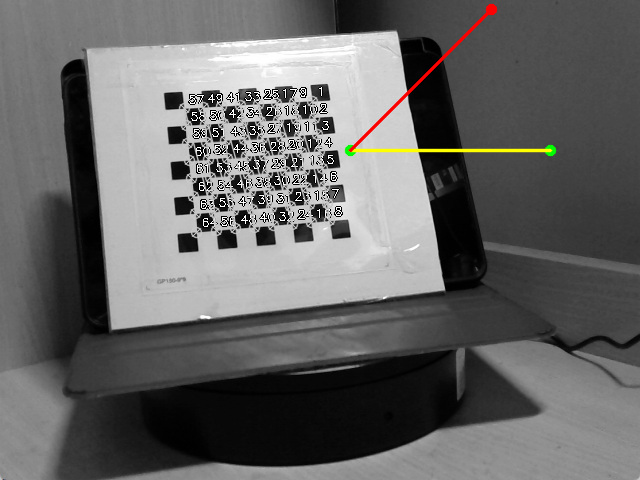OPENCV 基于旋转矩阵 旋转Point2f
测试效果
创建两个点,让第二个点绕第一个点转45度

代码解析
Mat a; a = imread(\"D:\\\\0.bmp\", -1);
读取一张图片当作背景板
Point2f p1(350, 150); Point2f p2(550.0f, 150.0f);
创建两个点
cv::Mat mat = getRotationMatrix2D(p1, 45, 1.0);
生成旋转矩阵,中心点为p1
std::vector points = { p2 }; cv::Mat srcPoint(points);
cv::Mat dstPoint; // 应用变换 cv::transform(srcPoint, dstPoint, mat);
创建结果Mat 执行矩阵变换
float x = dstPoint.at(0, 0); float y = dstPoint.at(0, 1); cv::Point2f rotatedPoint(x, y);
输出结果也是一个Mat对象 从这个Mat对象中取出仿射变换之后的点坐标数据
std::cout << \"Rotated Point: \" << rotatedPoint << std::endl; circle(mergedImage, p1, 3, Scalar(0, 255, 0), 3, LINE_AA); circle(mergedImage, p2, 3, Scalar(0, 255, 0), 3, LINE_AA); circle(mergedImage, rotatedPoint, 3, Scalar(0, 0, 255), 3, LINE_AA); line(mergedImage,p1,p2, Scalar(0, 255, 255),2,LINE_AA); line(mergedImage, p1, rotatedPoint, Scalar(0, 0, 255), 2, LINE_AA);
三个点坐标数据,绘制到图像上,以便确认执行正确。
原始代码
Mat a; a = imread(\"D:\\\\0.bmp\", -1); cv::Mat mergedImage; std::vector channels = { a, a, a }; cv::merge(channels, mergedImage); Point2f p1(350, 150); Point2f p2(550.0f, 150.0f); cv::Mat mat = getRotationMatrix2D(p1, 45, 1.0); std::vector points = { p2 }; cv::Mat srcPoint(points); cv::Mat dstPoint; // 应用变换 cv::transform(srcPoint, dstPoint, mat); // 提取结果 float x = dstPoint.at(0, 0); float y = dstPoint.at(0, 1); cv::Point2f rotatedPoint(x, y); std::cout << \"Rotated Point: \" << rotatedPoint << std::endl; circle(mergedImage, p1, 3, Scalar(0, 255, 0), 3, LINE_AA); circle(mergedImage, p2, 3, Scalar(0, 255, 0), 3, LINE_AA); circle(mergedImage, rotatedPoint, 3, Scalar(0, 0, 255), 3, LINE_AA); line(mergedImage,p1,p2, Scalar(0, 255, 255),2,LINE_AA); line(mergedImage, p1, rotatedPoint, Scalar(0, 0, 255), 2, LINE_AA); imshow(\"1\", mergedImage); waitKey();

